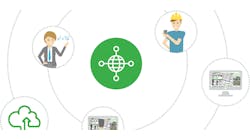Latest from C&E/NetDev Ops/GIS/Open-Source Networks
Six Benefits of True Network Visualization
All over the world, enormous sums are being invested in the telecom industry to support the roll out of full fiber networks. Whether planning, designing, building, or operating a network, the support of a “Digital Twin” is almost invaluable. A digital twin, which is a digital representation of a physical telecom network, presents a host of opportunities for everyone involved in the business—from investors and stakeholders to the entire workforce.
Alongside its multiple practical uses, a digital twin enables everyone involved in a project to combine around one version of the truth, it allows everyone to be proactive rather than reactive, and with the digital trace, everyone is also able to be held fully accountable.
Knowing the Network
With a digital twin, specific and detailed data about the network becomes available in a virtual form. It can answer the questions:
- What are the assets?
- Where are the assets?
- How are these assets connected?
- Who is using the assets?
This knowledge allows operators to analyze everything from the details of the age and life span of the cables to the condition they are in. Excellent support for failure analysis becomes available, as well as the knowing when maintenance is required. Telecom network providers can be on top of their game, fixing cables before they actually break, and keeping consumers up to date should planned outages be necessary.
Life cycle management is also critical to network providers. So, when they are planning, designing, operating, and maintaining the network they can keep the whole process, and the data related to it, collated in one digital system. It is with this data that reality is converted to the digital representation. During the respective processes, the digital twin is refined in every step. This allows the entire workforce access to one single source of truth which ensures greater efficiency when the network is working smoothly, and even when it is not.
Six Benefits of Digital Twins
Consider these reasons why telecom network providers need to embrace this technology to succeed:
- Traditionally, a field engineer would bring an activity list on a hard copy, or have a digital copy saved on an electronic device. The moment that data becomes a copy, it is a deviation from the digital twin. Clearly, it would be better that the field engineer work with a mobile device synchronized with the digital system. There, correct information will be available with no risk of potential changes affecting the task at hand. By taking a digital twin out into the environment, accurate and updated information is transferred to the digital system in real time rather than needing to be written up when back at the office. In-house staff and field engineers can see any changes made instantly.
- Customer care is (or should be) top of every telecom network provider’s agenda, and the digital twin allows customers to know about their connectivity at all times. With a digital twin, potential reconfigurations and equipment replacements or upgrades can be tested in detail. When put next to the connected “real” network, the impact of planned outages can be analyzed in minute detail. With this analysis, an outage communication plan can be created and sent to consumers via email, text messages, or letters. Outage maps, giving a visual view of affected areas, are also a perk of the digital twin.
- Investors and operators like to know the value of their assets, whether that is for raising new funding or part of a due diligence process. Being able to both show and prove key aspects via live network data helps validate valuable network assets.
- Future network potential can be accurately compiled and demonstrated using a digital twin. One example is the overview of homes connected and homes passed. The digital twin provides a clear and structured view of the data, which allows for an understanding of investments, incomes, and outgoings.
- Moving into 2023, this is a world where the risks of (or actual) war, terrorist attacks, and hostile infiltrations cast shadows on everyday life. The destruction of critical infrastructure would have devastating consequences. Security is therefore of utmost importance and demands protection from malicious attacks without affecting the accessibility of authorized users. Security is, to say the least, a complex matter, and frankly deserves a lot of attention. However, a very short summary of what to address regarding security when working with a digital twin would be:
• Outsider threats—where a digital system must be protected from infringement. The security
issues are related to protecting the actual digital system.
• Insider threats—which relates to the standards, processes, and routines of the workforce.
This includes training and an understanding of how sensitive data is to be handled.
6. Unintentional human error can also compromise security. Sensitive information going astray via
hard copy or email happens more often than we care to admit. Setting up a portal for a field
engineer who needs to change a cable in a certain area allows the field engineer to get exactly
the amount of information needed to execute the changes, at the actual time the data is needed.
“Alongside its multiple practical uses, a digital twin enables everyone involved in a project to combine around one version of the truth, it allows everyone to be proactive rather than reactive, and with the digital trace, everyone is also able to be held fully accountable.”
Today’s network providers must deliver connectivity to their customers, and results to their investors and shareholders. Digital twins are an invaluable tool for telecom providers looking to succeed with both of those objectives.

Joel Pirard | Vice President Sales Telecom, Digpro
Joel Pirard is Vice President Sales Telecom, Digpro. With extensive experience from the software industry, including areas such as business development, telecom, OSS/BSS, GIS, and NIS. He knows the true value of a digital twin. For more information, visit https://digpro.com/. Follow Joel on LinkedIn: in/joel-pirard-14b3032. Follow Digpro on LinkedIn: company/digpro-ab.




